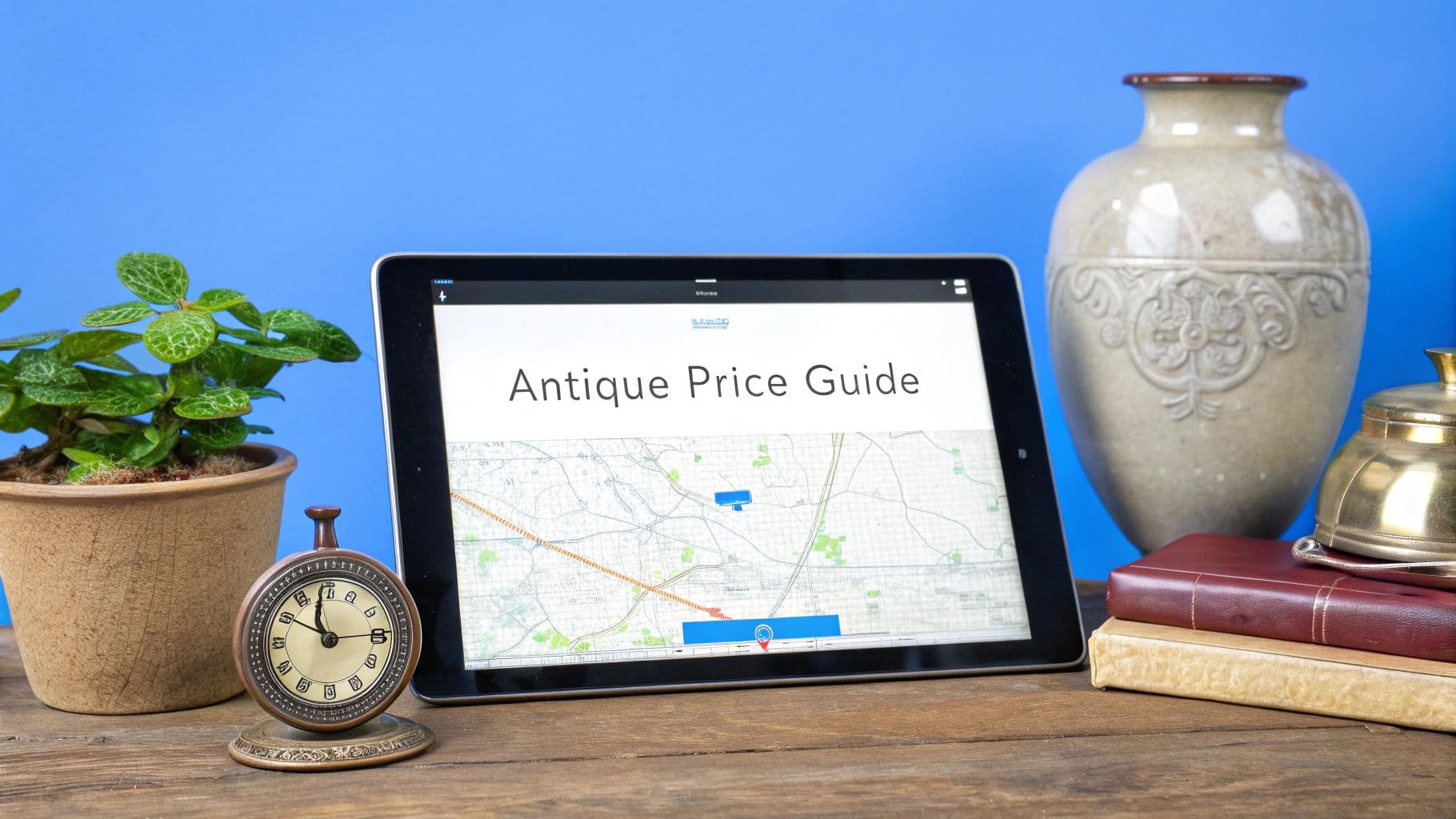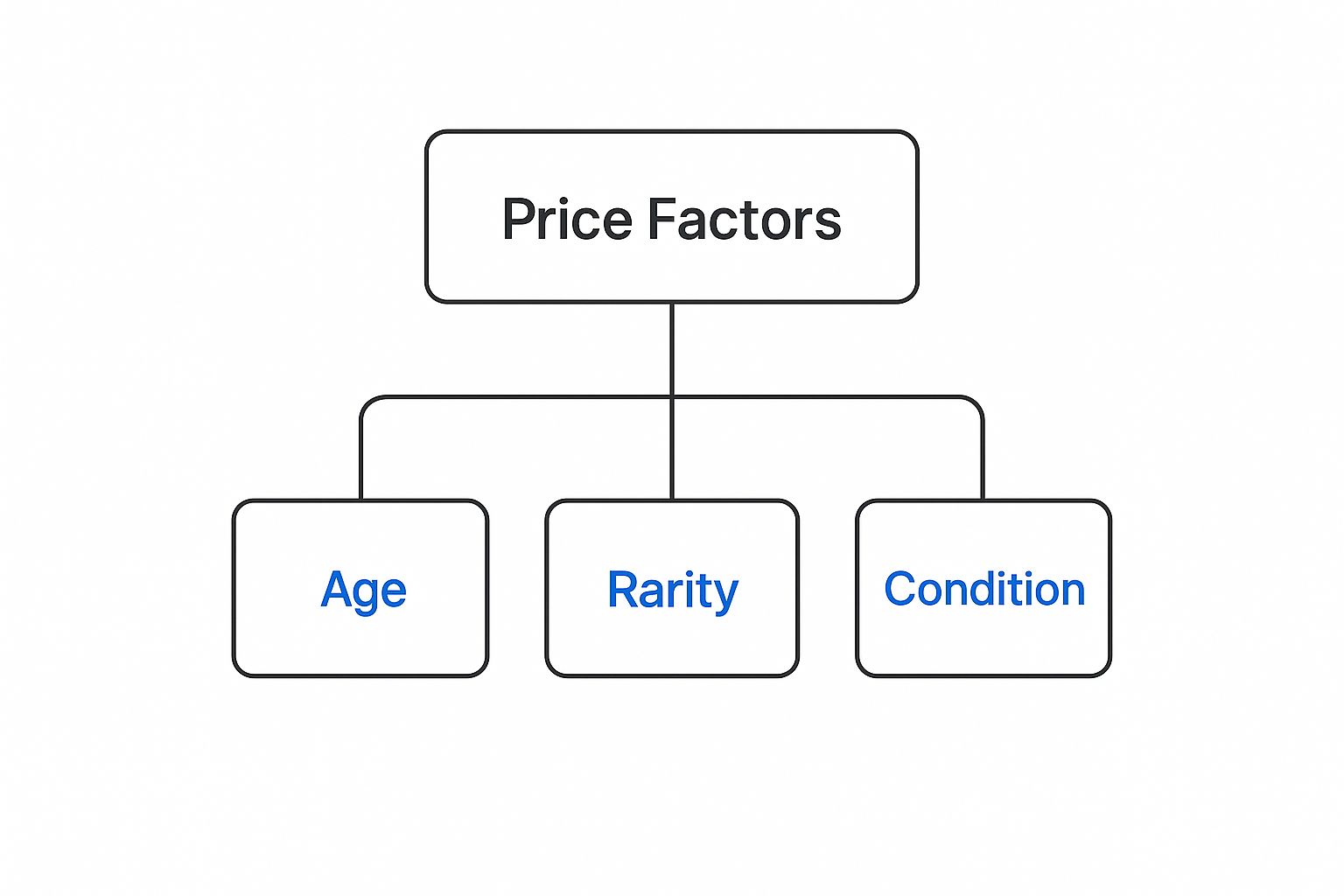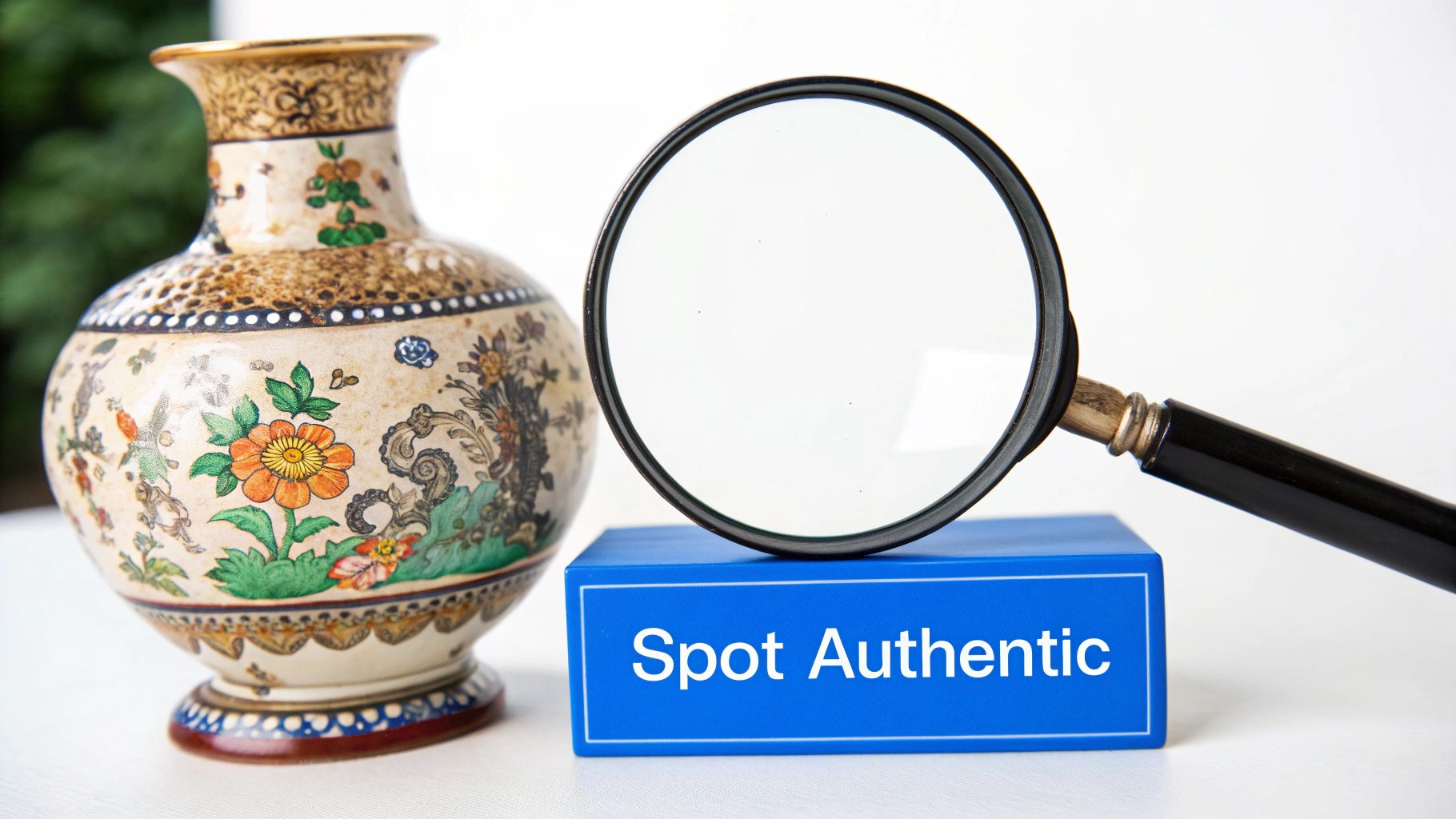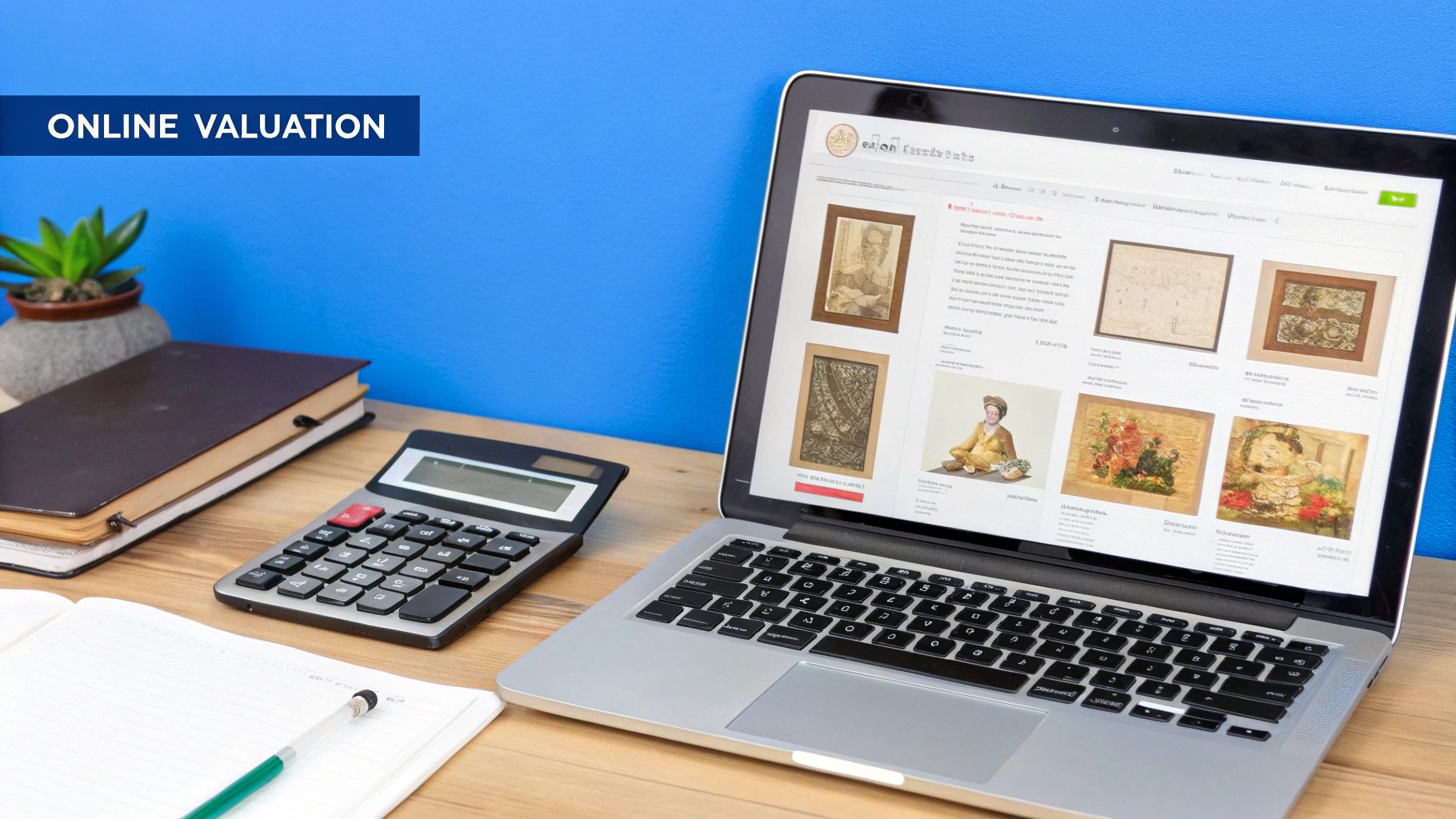Your Guide to Antique Price Guide Online

An antique price guide online is basically a digital database that pulls together the estimated market values for all sorts of vintage items and collectibles. It works by tracking recent auction results and dealer sales, giving you a live look at what your treasures are really worth today.
Think of it this way: it’s the modern, constantly updating replacement for those old, dusty print guides.
The Modern Collector's Digital Toolkit

We've all been there. You find a dusty, forgotten box in the attic or inherit a piece of furniture that just feels special. The first questions are always the same: What is this, and what's it worth?
Not long ago, finding those answers meant dragging the item to an appraiser or spending hours flipping through massive, printed books—which were often out of date the second they hit the shelves.
Thankfully, that's all changed. An online antique price guide is a dynamic digital tool that turns any collector with an internet connection into a confident, well-informed researcher.
Beyond a Simple Price Tag
A static, paper guide is like a printed map of a city that's constantly under construction—it's obsolete almost immediately. An online guide, on the other hand, is your live GPS.
It gathers huge amounts of data from multiple sources to paint a clear, current picture of an item's market value. This crucial information comes from:
- Auction Houses: Results from recent online and in-person auctions show what real buyers are actually paying for items.
- Dealer Inventories: Prices listed by reputable antique dealers from all over.
- Online Marketplaces: Sales data from platforms where collectibles are bought and sold every single day.
Pulling all this data together is the real magic of any good online guide. It takes you beyond a single person's opinion or an outdated estimate, giving you a value range that’s grounded in real-world, recent transactions.
An effective online price guide does more than just list a price; it provides context. By tracking sales over time, you can spot whether an item's value is trending up, holding steady, or even declining—critical info for both selling and investing.
Making Informed Decisions
At the end of the day, using an antique price guide online is about replacing guesswork with confidence.
Maybe you're a casual seller hoping to price an old family heirloom fairly. Or perhaps you're a serious buyer who wants to avoid overpaying at a flea market. You might even just be a curious owner wanting to know the story behind your things. In every case, these tools are invaluable.
They let you do your homework from your couch, compare similar items side-by-side, and understand the little details that drive value—like maker's marks, condition, and rarity. This knowledge gives you a serious advantage, making sure you make smart, educated decisions in the exciting world of antiques.
How to Choose a Reliable Online Price Guide
Not all digital valuation tools are created equal. Picking the right antique price guide online is a lot like choosing the right tool for a delicate repair job—you absolutely need precision and reliability. A basic guide might give you a rough ballpark figure, but a top-tier platform delivers the detailed data you need to make decisions with real confidence.
Think of it this way: a simple guide might tell you a generic "Victorian chair" is worth $200. A superior guide, however, lets you see that a specific Victorian balloon-back chair, made of mahogany with its original upholstery, consistently sells for $450 at auction. It would also show you that a similar but damaged one only fetches $150. That level of detail is the difference between a great find and a bad deal.
Look Beyond the Listing Price
The single most important feature of any reliable online price guide is where its data comes from. You have to use a platform that clearly separates "asking prices" from "sold prices."
- Asking Price: This is just what a seller hopes to get for an item. It's often inflated to leave room for haggling and is a shaky measure of true market value.
- Sold Price: This is the confirmed, final price an item actually sold for at auction or in a direct sale. This is the gold standard for valuation, reflecting what real buyers were willing to pay out of their own pockets.
A guide built on verified auction results gives you a much more honest snapshot of the market. Without access to that historical sales data, you’re basically just guessing.
A great online price guide doesn't just show you a single price. It presents a value trajectory, allowing you to see if an item’s worth has been increasing, decreasing, or holding steady over months or even years.
Key Features of a Top-Tier Guide
When you're comparing different platforms, look for a solid set of features that empower you to do some real research. The best guides offer way more than just a search bar; they provide a complete research environment.
Must-Have Features Checklist:
- High-Resolution Image Libraries: You need to be able to visually match your item to what's in the database. Clear, detailed photos from multiple angles are non-negotiable for confirming patterns, maker's marks, and condition.
- Advanced Search Filters: The ability to narrow down thousands of results is critical. Look for filters that let you sort by maker, artist, era, specific style (like Art Deco or Mid-Century Modern), and materials.
- Comprehensive Data Points: A price is just a number without context. A professional-grade guide will always include the date of sale, the auction house where it sold, and a detailed description of the item, especially its condition.
When an online price guide pulls all these features together, it transforms from a simple lookup tool into a powerful analytical asset. This infographic really breaks down the core factors that all pricing data ultimately rests on.

This hierarchy makes it clear: an item's age, rarity, and condition are the foundational pillars that determine its final market value. By arming yourself with a guide that provides these critical details, you can evaluate your antiques with the insight of a seasoned professional.
Essential Features of High-Quality Online Price Guides
The quality of an online price guide can vary dramatically. Understanding the differences between basic, intermediate, and professional-level tools will help you choose the right one for your needs, whether you're a casual browser or a serious collector.
| Feature | Basic Guide | Intermediate Guide | Professional Guide |
|---|---|---|---|
| Data Source | Mostly asking prices, user-submitted data | Mix of asking and sold prices, some auction data | Verified auction results from multiple houses |
| Image Quality | Low-res, single-angle photos | Good-quality images, sometimes multiple views | High-resolution, multi-angle, zoomable images |
| Search Filters | Basic keyword search only | Filters for category, era, sometimes material | Advanced filters: maker, artist, auction house, date range |
| Historical Data | Limited or no historical price tracking | Shows recent sales (last 1-2 years) | Deep archives, price trends over 5-10+ years |
| Item Descriptions | Vague, minimal details provided | Includes basic dimensions, material, style | Detailed descriptions, provenance, condition reports |
Ultimately, a Basic Guide is fine for a quick, rough estimate. An Intermediate Guide is useful for hobbyists who need a bit more context. But for serious buying, selling, or appraising, a Professional Guide with its rich, verifiable data is the only tool that gives you the complete picture.
The Evolution From Print to Digital Valuations

Not long ago, if you wanted to know what an antique was worth, you reached for a book. For decades, hefty printed guides like the Antique Trader Antiques & Collectibles Price Guide were the gold standard. They were—and still are—incredible resources, packed with photos and expert insights that literally helped define the market.
But there’s a catch with print. A printed guide is like a snapshot. It perfectly captures the market at one specific moment, but it can’t show you what happens next. Since they’re typically updated just once a year, they can’t keep up with sudden market shifts. A collectible that was red-hot in January might be ice-cold by June, but you wouldn’t know it from last year’s book.
The Shift to Real-Time Data
This is where the antique price guide online completely rewrote the rules. Instead of that yearly snapshot, digital platforms are more like a live stock ticker for collectibles. They pull in sales data as it happens, giving you a value that reflects the market’s pulse right now—not six months ago.
This immediate access has been a game-changer. Information that used to be guarded by seasoned dealers with entire libraries of reference books is now just a click away for anyone. It levels the playing field, empowering regular folks and new collectors to make smarter, more confident decisions. And once you have a good idea of an item's value, you can immediately figure out where to sell antiques online to get the best price.
The real difference isn't just about speed; it's about accessibility. Digital guides transform valuation from a static, gatekept resource into a dynamic, open conversation where current sales data is the common language.
A Hybrid Approach for Modern Collectors
So, should you toss out your old books? Not so fast. Printed guides still offer tremendous value. A classic like the 'Antique Trader' guide, with its thousands of photos and deep historical context, is fantastic for identifying a piece or understanding its background. They’re unbeatable for deep-dive research, even if they aren’t great for a quick price check.
Frankly, the smartest collectors and sellers today use a hybrid strategy. They’ll grab a book to identify an obscure maker's mark or learn the history behind a piece of furniture. Then, they hop online to see what that exact item has actually sold for in the last few weeks. It’s the perfect blend of historical context and real-world, up-to-the-minute market value.
Using Price Guides for Smart Antique Investing
A top-notch antique price guide online is so much more than a simple price checker. For experienced collectors, it’s an essential tool for building a real investment strategy. They aren't just looking up one item; they’re using these guides like an analyst uses a market dashboard—spotting trends, finding undervalued categories, and making calculated moves that turn their passion into a serious portfolio.
It’s the difference between being a passive owner and an active market analyst. By digging into the historical sales data buried within a good guide, you start to see which types of antiques are picking up steam and which are hitting a plateau. This data-first approach helps you build a much smarter, more resilient collection.
Identifying Market Trends and Opportunities
The real trick is learning to spot the patterns. Is a certain style of Mid-Century Modern furniture consistently blowing past its auction estimates? Are the prices for a particular pottery maker steadily creeping upward? Answering these questions helps you find those hidden gems before everyone else does.
For instance, a fascinating trend we're seeing is a huge surge in demand for 1980s collectibles, from vintage video games and toys to early personal computers. This isn't just random; it's being fueled by Millennial and Gen X nostalgia, cultural touchstones, and the simple fact that these items are getting harder to find. As younger buyers enter the market, they see these pieces as both sentimental treasures and legitimate assets. It’s a perfect example of how the definition of "valuable antique" is always changing. For more insights, the Goodson Gallery's 2025 trend report is a great read.
Building a Balanced Collection
Using an online price guide is also key to managing your risk by building a well-rounded collection. Let's be honest, not every piece can be a record-breaking showstopper. A savvy investment strategy usually involves a smart mix of items.
- Anchor Pieces: These are your high-value, rare items that form the bedrock of your collection's worth. Price guides are invaluable for verifying their market value and tracking their performance over time.
- Accessible Items: Think of these as the more common, lower-priced antiques you can pick up more easily. They add wonderful depth to your collection and are often easier to sell if you ever need to free up some cash.
This balanced approach lets you enjoy the high-risk, high-reward thrill of unique anchor pieces while grounding your portfolio with the stability of more accessible collectibles.
An online price guide helps you move past purely emotional buys. It gives you the hard data needed to balance your portfolio, ensuring your collection isn't just beautiful, but also financially sound and strategically built.
Once you get comfortable with the data inside an online price guide, you can start forecasting trends, diversifying your holdings, and building a collection with real long-term value. This is especially helpful if you're planning your own sale, since understanding the market is a huge part of successful estate sale marketing.
A Step-by-Step Guide to Valuing Your Antiques

When you hold an antique, you're holding a piece of history. But how do you translate that history into a dollar amount? Using an antique price guide online isn't just about typing a name into a search bar. It’s a process of discovery that starts long before you even open your web browser.
Your first job is to play detective. Before you can figure out what something is worth, you have to know exactly what it is. This initial investigation is the bedrock of an accurate valuation.
Step 1: Start with Identification
Before you can price your item, you have to identify it. Start by examining it closely for any tell-tale marks. These are the fingerprints left behind by the creator, and they can tell you who made it, where it came from, and roughly when it was produced.
Look for these key details:
- Maker's Marks: Check the bottom, back, or even inside for stamps, signatures, or symbols. This could be anything from a company logo to an artist's initials.
- Materials: Is it solid oak or a pine veneer? Sterling silver or just silver plate? These differences can change the value dramatically.
- Construction: Look at how the piece was assembled. Hand-cut dovetails on a drawer suggest an older, handcrafted piece, while staples or modern screws point to something much newer.
These clues are your starting point. If you get stuck, our guide on how to identify valuable antiques can give you more detailed pointers.
Step 2: Conduct Your Online Search
Once you have your initial findings, you're ready to hit the online price guides. Effective searching is an art form. Instead of a vague query like "old vase," you need to use the specific details you've gathered.
Try searching for "Johnson Bros Ironstone Platter Heritage" or "George Jones Coffee Pot c. 1880." The more specific your keywords, the better your results will be. Carefully compare the photos in the guide to your item, paying close attention to details like patterns, shapes, and markings to confirm you've got a match.
Don't just settle for the first result you see. A true market value is almost never a single number. It’s a range you discover by looking at multiple sales to build a complete and accurate picture.
Step 3: Analyze and Interpret the Results
After you find some comparable items, it's time to dig into the numbers. You need to look for actual sold prices, not just what people are asking. A sold price is proof of a real transaction, making it the most reliable indicator of what an item is currently worth.
As you analyze the data, always consider two critical variables that can swing the price:
- Condition: Is your item in mint condition, or does it have chips, cracks, or repairs? Be brutally honest with your assessment. Even minor damage can slash the value.
- Provenance: Do you have any paperwork or a story about the item’s past? A documented history, especially one linking the item to a famous person or event, can add tremendous value.
Step 4: Know When to Call a Professional
An online price guide is a fantastic tool for research and for getting a solid valuation on most common antiques. It's perfect for pricing items for an estate sale or just satisfying your own curiosity.
However, if you have a hunch that your item is exceptionally rare, historically important, or could be worth a lot of money, it's time to step away from the keyboard. This is when you should consult a certified appraiser for a formal, professional valuation.
Got Questions? We've Got Answers
Stepping into the world of antiques can feel like learning a new language, and using digital tools for the first time naturally brings up questions. Don't worry, that's a normal part of the process. Getting solid, straightforward answers is how you build the confidence to buy, sell, and collect like a pro.
Think of this as your quick-start guide. We've gathered some of the most common questions we hear about using an antique price guide online and answered them in a way that makes sense.
How Accurate Is an Antique Price Guide Online?
This is probably the most important question, and the honest answer is: it's complicated, but they are incredibly useful. A top-tier online guide is your best bet for finding a fair market value range. They pull in data from countless real-world auction results and dealer sales, giving you a live look at what things are actually selling for right now.
But here’s the key thing to remember: a guide gives you a data-driven estimate, not a guaranteed price tag. The final sale price is always a story told by factors a database can’t see—the specific condition, a unique history (provenance), or just two bidders who really want it that day. Think about it: two seemingly identical 19th-century ironstone platters will have different values if one has a tiny, hidden chip and the other is absolutely pristine.
Think of an online price guide as your starting point. It establishes a strong, data-backed baseline for an item's value, so you can price, buy, or insure your piece with real information instead of just a hunch.
What Is the Difference Between a Price Guide and a Professional Appraisal?
While both are about figuring out an item's worth, they serve completely different roles. It’s a bit like using WebMD to check your symptoms versus getting a full physical from your doctor.
An antique price guide online is a research tool. It gives you an estimated market value by showing you what similar items have sold for. It's fantastic for your own curiosity and for making everyday decisions when you're buying or selling.
A professional appraisal, on the other hand, is a formal, legally recognized valuation. A certified expert physically inspects your item, does deep research, and provides official documentation. You absolutely need this for situations like:
- Insurance coverage and claims
- Estate planning and settlement
- Tax deductions for charitable donations
- Legal matters like divorce proceedings
The bottom line? Use a price guide for your day-to-day research. Hire a professional appraiser when you need an official, documented value for legal or financial purposes.
What Should I Do If I Cannot Find My Item in an Online Guide?
It’s definitely a letdown when you search for your treasure and come up empty. But don't give up—this is when you need to think like a detective.
First, try changing up your search terms. Instead of looking for a super-specific "1885 George Jones & Sons Crescent China Teapot," broaden your search. Try something simpler like "George Jones teapot" or even more general, like "Victorian earthenware teapot." This casts a much wider net and can help you find comparable items.
If you still can't find it, that could be a very good sign. It might mean your item is genuinely rare or so unusual that it hasn’t sold at a public auction recently. If there’s no recent sales data, the guide has nothing to show you. When this happens, you might have something truly special on your hands. Your next best steps are to check in with specialized online collector forums for your item's category or to seek out a professional appraisal. Experts in the field often have access to private sales records and the experience needed to value a one-of-a-kind piece.